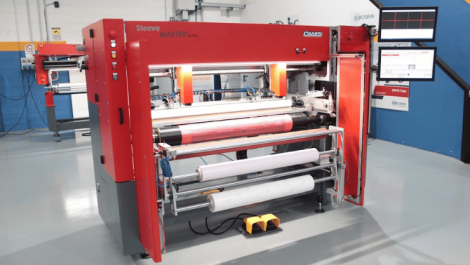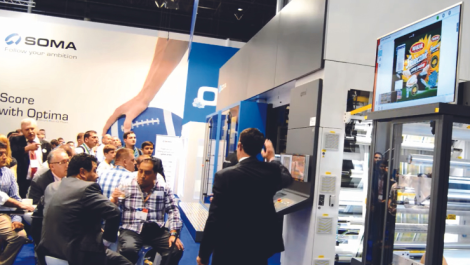Like a world class conductor at the head of the orchestra, MIS software today increasingly plays a role in synthesizing multiple business and production systems into a unified infrastructure that can drive a print operation forward through automation and integration.
The MIS extends into many places these days, and as time goes on its developers intend for it to increasingly become an automating and integrating influence inside a printer’s operation.
We are already a good way down this road. MIS vendors supplying markets such as labels and packaging, where flexo print is strong, are able to report that a wide range of processes within a print company can already be automated using their software, with seamless flows of data exchange between the MIS and a potential wealth of other digital control systems being entirely possible right now.
It is easy, perhaps, as a printer to think of automation in terms of helping today’s workforce with setting up job parameters on printing and converting machines on the fly, to ensure quick turnarounds and less errors. That is obviously part of the equation – and MIS has a role here too – but automation is also much more than this.
Consider this comprehensive list, provided by Theurer, the German developer of the C3 ERP/MIS for the flexible packaging sector, of the key components in its software that drive automation:
- Production Planning and Scheduling: helping to optimise machine utilisation and minimise downtime.
- Fully Automated Production Optimisation with AI: offering multi-dimensional optimisation capability to find the optimal trade-off between absolute on-time delivery and efficient machine utilisation.
- Workflow Automation: streamlining job scheduling, resource allocation, and task assignment, minimising manual intervention.
- Inventory Management: automation ensures optimal inventory levels, reduces waste, and lowers the risk of stockouts.
- Quality Control: automation tools facilitate real-time quality monitoring and inspection, enabling early detection of defects and deviations.
- Real-time Data Integration: seamless integration with diverse data sources and production equipment to enable real-time monitoring and analysis, facilitating proactive decision making and timely interventions.
- Supply Chain Optimisation: optimising inventory management, procurement, and logistics operations, enhancing collaboration with suppliers, and ensuring on-time delivery.
- Customer Relationship Management (CRM): automation extending to customer interactions, streamlining order processing, invoicing, and customer support processes.
Theurer CEO Tobias Theurer adds that while technology such as artificial intelligence (AI), machine learning (ML) and the Internet of Things (IoT) are already starting to be utilised in the MIS, much more is to come.
‘As technology continues to evolve, we can expect further improvements in interface functionality, deeper integration with emerging technologies, and expanded automation capabilities to increase efficiency, agility, and competitiveness,’ he said.
Tuning the orchestra
Tuning the orchestra While all of those components listed above are important and useful in their own right to bring automation to the running of the business, it is the destiny of MIS to play a more profound role as the centrepiece of the entire operation, reaching into factory and warehouse optimisation and supplier collaboration, according to Kevin Blakey, director of product management – packaging, at ePS.
He said, ‘The ultimate automated factory has all the machines talking to each other. You fire the job into the factory and automation takes over. The automated warehouse knows that the truck with the reels of paper on it has arrived, and at an appropriate time it knows there’s a job that needs those reels. They are delivered to the press, which is automatically set up. What’s not there is the orchestration of that, and that’s what the MIS will do. It will sit in the middle to orchestrate all those processes.
‘We are very flexible in taking data from the system and interacting in almost real time. The MIS suppliers are kind of leading the way in that. We are doing a lot to move this forward, including by being very flexible and adapting to what is there. We are getting real work done in the field, knitting these solutions together, interacting with processes, including digital and warehousing. We are talking to the finishing manufacturers. People talk about AI and ML, but we have come to realise that there is no one complete solution out there yet, and we have got to be flexible. That’s what we have done with our toolset: make sure we can integrate pretty much anything to anything.’
Mr Blakey’s view is that AI will become a fundamental part of the MIS, but much of that development is still to come. What is important now is being able to capture and build the knowledge of the experts within print businesses into the MIS, so that automation can constantly utilise this knowledge, whether the experts are still in the business or not, to ensure robust business continuity. Once the business rules are integrated, technologies such as AI and ML will be able to use the data derived from them to eventually start ‘tapping on the shoulder’ to say, actually, here is a better way to do things.
There is a lot of communication around workflow and business processes that can also be automated. ‘It’s important for people to realise they have those already today, without massive investment, and it’s not scary, it’s relatively straight forward,’ said Mr Blakey.
That notion of ‘orchestration’ is highlighted by Tobias Theurer also, in terms of the role of MIS in what is increasingly being described as an ‘ecosystem’ of software that printers are using. He said, ‘As part of this ecosystem, ERP/MIS software like C3 will play a key role in orchestrating end-to-end processes, facilitating collaboration, and enabling data driven decision making. This will allow packaging and label companies to optimise operations, increase agility, and drive business growth in a highly connected and dynamic environment.’
Orders under interrogation
One of the key processes that can be automated in the MIS is to interrogate incoming orders, grab the key data and use it to automatically create the job. This has been difficult to bring automation to because the methods customers use to deliver jobs to printers have traditionally been so varied, and not always digital in nature.
Label Traxx president Rob Mayerson says this is changing. ‘Through talking to label converters, we’ve found the most common way customers submit jobs into a label plant today is by email with attached purchase orders from their system. Instead of relying on these segmented interactions, Automated Order Entry, a function of our Siteline Customer Portal, creates job tickets from customer POs automatically.’
For Label Traxx, the point of automation is to ‘improve workflow by cutting mundane tasks’, which also reduces the errors that manual processes are prone to. ‘We think developing our products to automate more mundane tasks will create more time for employees and production workers to focus on strategy, improve efficiency, and make more informed business decisions,’ said Mr Mayerson.
The company is integrating with different systems more and more every day, Mr Mayerson continues, and he points to the ‘obvious benefits’ that come from integrating prepress automation with Label Traxx’s proof approval processes, as well as integrating with print and finishing equipment.
‘The same set of integration tools and methodology are being used with our systems at an increasingly rapid pace. Examples could be administrative in nature – like Sales Tax, Accounts Payable or Accounts Receivable integrations. Tools for integrating with Business Intelligence have become increasingly popular as well.’
Smart automation
Acting as the ‘pivotal component of an integrated software ecosystem’, CERM says its label and packaging industry-specific MIS enables businesses to ‘streamline operations, reduce inefficiencies, and capitalise on the opportunities presented by digital transformation and industry consolidation’. The company says that partner integration is in its DNA, and indeed it has developed a formal program of these partnerships to enhance manufacturing automation, which includes leading flexo and digital press manufacturers and finishing equipment suppliers.
The interaction of these systems with a centralised MIS means that work can be automated in ‘smart ways’, the company adds – ways that ‘you might not have imagined when focussing on every single workflow element individually’.
Beyond this, CERM highlights a further benefit of this growing trend of centralised information flowing through the MIS/ERP, that can be shared with other systems: the area of regulatory compliance.
‘More and more printers and convertors are struggling with finding experienced people,’ says CERM. ‘Having to comply with new regulations (for example, e-invoicing, PPWR, energy efficiency, renewable sources, and food traceability) is a clear evolution that requires more digitisation, and an up-to-date ERP for the labels and packaging converting industry.’
This feature article was first published in the March issue of FlexoTech, which you can read online here; register here to receive future issues of the magazine






